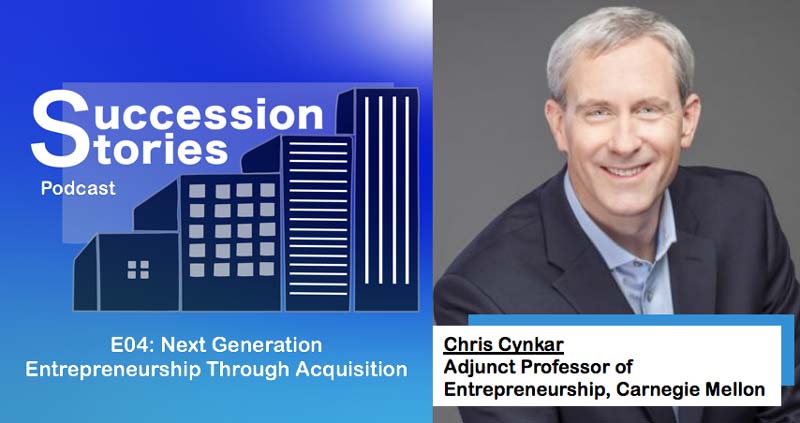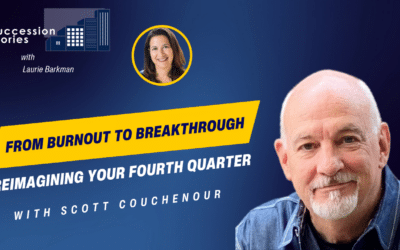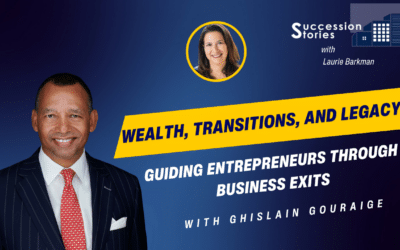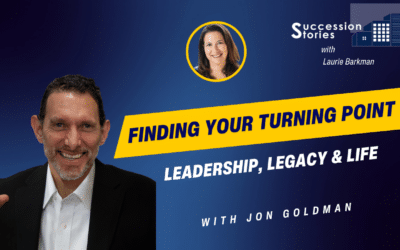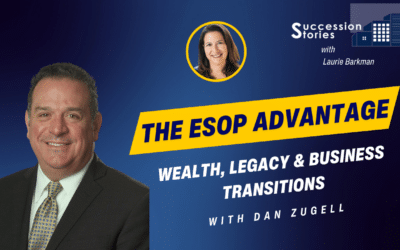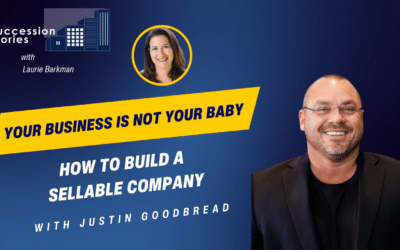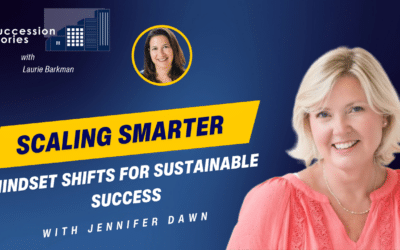This episode of Succession Stories provides insights for people considering a different path, transitioning from employee to business owner. Laurie Barkman spoke with Chris Cynkar, Adjunct Prof. of Entrepreneurship at the Tepper School of Business at Carnegie Mellon. Chris shared his experience acquiring different businesses and how he built a successful career as a next generation entrepreneur.
Show Links:
Carnegie Mellon University Swartz Center for Entrepreneurship
Recorded in-studio with special thanks to Carney.co – Pittsburgh, PA
Full Transcript
Laurie Barkman (00:00):
Welcome to the Succession Stories podcast, innovation insights for next generation entrepreneurs. I’m Laurie Barkman. I spoke with Chris Cynkar, Adjunct Professor of Entrepreneurship at Carnegie Mellon University’s Tepper School of Business. His passion is entrepreneurship by acquisition and he has bought and sold multiple businesses over the past 15 years. It was interesting to hear about Chris’s first success as a next generation business owner when he acquired a mature printing company from its founder. Chris reflected on this relationship and its parallels beyond the business transaction for the owner. It was as much about legacy as it was about fair market value. In taking over the business, Chris fulfilled the owner’s intent of a succession plan even though he wasn’t family. I think you’ll enjoy hearing Chris’ stories about successful business transitions with insights for sellers and new owners alike, and his tips for building enterprise value.
Laurie Barkman (00:59):
Chris, I’m so excited to sit down with you today and hear your succession story, so thanks for joining me.
Chris Cynkar (1:02):
It’s my pleasure to be here. Laurie, thanks.
Laurie Barkman (1:05):
So I want to just to get started by having you talk about your entrepreneurial career, you’ve done so many amazing things. What got you started in entrepreneurship?
Chris Cynkar (1:10):
You know, it’s kind of an interesting story. So when I was a kid, I lived in a family where entrepreneurship was a little bit of a complicated subject. So my dad was for his whole career, a banker. And as his career developed, he moved into commercial lending. So he came from a background, which was very conservative, risk averse, always looking for what could go wrong and trying to protect on the downside. My mom on the other hand, was completely different. My mom was an entrepreneur and in her career, she actually started and owned multiple different businesses.
Chris Cynkar (01:51):
So business ownership in our house was a topic when I was a kid that was always pretty openly discussed. But there was an interesting banter back and forth between my mom who had all of these budding ideas and dreams of business ownership and my dad, who would just sit back with his arms crossed and just kind of evaluate what could possibly go wrong with that business. And to him there was a long list because that’s what he was trained to do. So as I started my career, I started out in this very conservative, staid way of doing things. I started out as an accountant and early on in my career I worked for a large accounting firm and I was doing auditing and tax work. But over a period of time I started to realize that the business owners, the people who looked more like my mom’s career, it was just a lot more interesting. So as I was finishing up my MBA, I started to take some entrepreneurship classes. And in doing that I got exposed to a whole world of business that to me was far more interesting and that what I was doing in my day job at the accounting firm. And so I graduated and about nine months later I ended up buying my first business.
Laurie Barkman (03:07):
I want to learn more about that. That was an interesting story about your parents because one was conservative risk averse and the other one was all about growth, which is probably very interesting as you headed in to get your MBA and then chose that field of entrepreneurship. So now we’re flash forwarding a little bit and you’ve decided to buy a business. Tell me about that.
Chris Cynkar (03:29):
So as I was finishing my MBA and taking some of these entrepreneurship classes, we had a guest speaker come in to one of the classes that I was taking at Carnegie Mellon and the guests who came in presented this idea of entrepreneurship, not by starting a business, but instead by acquiring an existing business that was ready for a transition in ownership ready for succession planning. And from my training as an accountant, that made sense to me because I wasn’t trying to go out and create something from scratch that didn’t exist today. But instead what I was going into was a situation where I was evaluating a business, identifying where there were items that could be changed and grown and modified, and then going and executing on that. And that fit my skill set better. And so when I graduated, I made a decision to start on a path of looking for and acquiring a business. And that process for the first business that I acquired, Laurie, took probably about eight months of pretty dedicated effort to find that first business.
Laurie Barkman (04:33):
How focused were you? How did you know what type of business you wanted to buy and tell us about that eight months?
Chris Cynkar (04:41):
So I think it’s like a lot of things in our lives is that you start out with a pretty general idea that you have a goal but you don’t have any idea what the end game is going to look like. All right. So I started by looking at just all whole array of different opportunities, different industries, different sizes of business, different locations. And after probably six, eight, 10 weeks after I had looked at a few dozen opportunities, I had narrowed in on a core criteria list. And my criteria list for that first acquisition was actually quite simple. I wanted a business that for me, number one was small enough that I could wrap my arms around it and really understand it with ease. Because at this point in my career, Laurie, I was pretty early on in my career. I was in my mid-twenties and didn’t have a lot of executive leadership experience, didn’t have a lot of team leadership experience. So I needed something that was small.
Chris Cynkar (05:35):
Second, financially I was early on in my career and didn’t have a big bank roll to work with. So I needed something that was affordable. And then the third piece is I had grown up in Pittsburgh, I enjoyed living in Pittsburgh and I didn’t want to move. So I wanted something that was in relative close proximity to where I was living in the city.
Laurie Barkman (06:01):
Did you have any advisors helping you look for a business?
Chris Cynkar (06:03):
So during the early stages of my process it was go out and look at things, come back and ask a team of advisors what do you think about this? And then go back out with that commentary and start refining my search process. And so I did iterate multiple times with a group of advisors, some of those advisors from graduate school at Carnegie Mellon, some of them actually other business acquirers who had been referred to me by the faculty members.
Laurie Barkman (06:32):
Interesting. And you are inspired by this discussion where this entrepreneur had come in and he was talking about his interests perhaps in, in selling his business, starting to talk about succession planning. And then you went out, you started to look for a business. So what did you find? What ultimately became your acquisition?
Chris Cynkar (07:00):
So I ended up acquiring a small printing company in Hermitage, Pennsylvania. The company is called Shenango Valley Quick Print. And this was a business that had quite an interesting history. So I acquired this business in 1999 so it’s been quite a while. But the business, at the point that I acquired, it was actually 23 years old. The gentleman who was the founder of that business set up the business when he was 40. He was now 63, he was slowing down. He realized that he was looking for a transition of ownership.
Chris Cynkar (07:26):
And what I saw in the business was a stable, solid business that fit my investment criteria. And I also saw an opportunity with that business to step into something that I believed could be dramatically larger and more successful than it was at that point.
Laurie Barkman (07:40):
Okay, so he’s 63 and why was he looking for an outside solution as opposed to maybe transitioning with a family member?
Chris Cynkar (07:45):
So I think this is actually at the end of the day, this issue, Laurie, is why I ended up buying that business. So the dynamics of the relationship that I had with the seller, the seller’s name was Tom. The dynamics there were really interesting. Tom, as I said, was 63. My dad was 62. I was at that point 26 years old. Tom’s son was 28 so there was very much between Tom and I, a dynamic of father and son. Tom’s son had worked in the business at varying points over the 23 years that Tom had owned the business.
Chris Cynkar (08:33):
I think Tom’s dream and his goal was that this would become a generational transfer, that his son would take over the business, re-energize it and grow it. His son just didn’t have any interest in that business. And I think that’s pretty common among family owners who want to have that family generational transition. There’s not always a next generation who wants that business. So I think the dynamic that Tom and I developed together was very much that I was the next generation who looked like his son who could re-energize the business. And to me, Tom was kind of my pseudo dad that he was there to help me develop my leadership skills, help me become a business owner for the first time, helped me to learn how to lead people. So I think for both of us there was a really warm and welcoming and open dialogue about how to transition the business well.
Laurie Barkman (09:36):
How long did Tom stay in the business?
Chris Cynkar (09:38):
So Tom and I agreed at the sale of the business that we would agree to a two year transition. All right. And in retrospect and in subsequent transactions that I went through, I realized two years is a very long transition window. So as we went through the transition window, I would say that the first six months were wonderful. I was very much at that point in listen and learn mode and Tom was very comfortable educating, teaching, helping me to develop relationships in the community. That was a great six months for both of us. The second six months is when I felt as if I had developed enough of a base of knowledge, developed enough comfort level that I was then ready to start implementing some changes in the business and I worked with Tom pretty carefully to explain those changes to him even though I wasn’t seeking his approval.
Chris Cynkar (10:35):
What I was seeking was for him to buy into them so that we could co sell them to the team and co sell them to the clients. It was after we reached the 12 month mark that I became more comfortable and really were starting to make some pretty dramatic changes in the business. That ended up being very fruitful. But for the seller it was very uncomfortable because I was changing a lot of what he believed to be the core of the business, but what I believed to really be busy work. And so that in that third six month window is when Tom and I had a heart-to-heart breakfast and he explained to me that he felt very uncomfortable, and I explained to him that I felt constrained. So we agreed that over that six month window he was going to phase himself out of the business. And that was mutually agreed to when we were both comfortable with it at the end of the day. But it was a really difficult conversation.
Laurie Barkman (11:30):
Really interesting. I just want to unpack some of the things you talked about. There one was the transition time of two years. There’s a whole lot of things we can talk about in this dynamic and getting your hindsight on what you might do differently, and what guidance you might have for owners, new entrepreneurs in the business. I think this is why I want to kind of double click on it. So when he was there, was Tom physically in the office with you most of the time?
Chris Cynkar (12:08):
For the first 12 months, he showed up at the office every morning at 7:30 just as if he still owned the business.
Laurie Barkman (12:14):
And what did that dynamic entail for the employees? Was it confusing?
Chris Cynkar (12:17):
So I think that Tom went out of his way to truly delegate all authority and decision making to me. And that was something that we had agreed to on day one. And when an employee would approach him with something other than a very basic inquiry, he would 100% of the time delegate and tell them they had to ask Chris. So I think that part of the relationship, there was no confusion about day to day decision making, a day to day leadership. Both of us were very comfortable and Tom really checked his ego at the door and gave that away on day one. The more strategic conversations of what was happening behind the scenes that was far more challenging because those were conversations that Tom and I were having about this slow but steady transition of phasing out of certain types of business that Tom had started, introduced, felt pride with, that I believed were not profitable and were not really the future of where I wanted the business to go. So those conversations were much, much more difficult and took a lot more buy in from him.
Laurie Barkman (13:25):
So in retrospect, what do you think you would do differently or how would you advise someone in this situation?
Chris Cynkar (13:28):
So my experiences in subsequent businesses that I’ve purchased in my recommendation to people who are looking at this type of transition is that I believe 95% of everything that you’re going to learn from a seller, you can learn in about 90 days. Now there’s some element of it that there’s nuances that you would like to pick up later. But what I normally recommend to people is that I think a three month leadership transition of that person being in the office every day is plenty. Having them available on a consulting basis for another period of time where they can come in for a meeting or you can go have breakfast with them and chat with them to talk through issues. I think that’s an important availability, but I don’t think it’s crucial for them to be in the office. I actually think it’s counterproductive after a relatively short transition window.
Laurie Barkman (14:30):
I understand that and had somewhat of a similar experience at a company that I worked at and where there was a leadership transition. What I observed in my experience was an organizational readiness to move forward. And to follow the new leader. And so with Tom still being there, and then over time you having these new ideas, I can understand why that path forward might have been a little bumpy and took longer, but can you tell us about some of the things that you did as a leader to bring your team onboard?
Chris Cynkar (15:05):
So I think that w what’s interesting is when a new owner steps into a business, what the employees are primarily concerned about is how is this going to impact me and my family and this business. Am I going to have a future here? And so the lesson that I took going in, that I implemented from some mentors who I had talked to, they said, you have to listen all the time and don’t take any action until you’ve really solicited broad-based opinions. Okay. So the first item that I did was I listened to every one in the building. I spent the first probably month or so that I was in the building job shadowing every employee. And so I really stood in their shoes. I learned what they did every day and I really spent time to understand the nuances of what made them happy, what made them sad, what they liked and what they didn’t like, where the built-in challenges were. So it gave me a deep understanding of the business, but it also built a tremendous amount of credibility with the employees that I was really listening to them and that I cared to understand what their role was like in the business.
Chris Cynkar (16:25):
Every day when I want to introduce something new into the business, I spent time to not just tell the employees what the decision was but to explain to them why and how. And I think that that’s been another common theme that I’ve really tried to implement in my career is having very open communication with my employees and with my partners is an absolutely essential element in a transition to having people not only understand it, but buy into it and giving them a voice to ask questions, to get answers, to express their opinions. It doesn’t mean you have to change and it doesn’t mean that they’re going to love it, but what it does mean is that you’ve given them a voice so that they feel as if they were heard and therefore they can move past their objections and move into understanding why that could be good for them.
Laurie Barkman (17:23):
Well, because you were spending days in their shoes, you understood the roles, you listened, you got to know them as people. You probably knew the names of their pets and their kids and you showed that level of interest. You were listening. As I would say you’re on a listening tour. For a period of time that was quite significant to really understand the business and hear what issues there were and opportunities were out there. So then when you came back to them with ideas, the majority maybe were even coming from them. So they knew for sure they were being heard. And you got the buy in. There’s a great book by Simon Sinek, Start with Why. If you’ve seen his videos, he really does a nice job at presenting “why is the why important?” And you’re right, there are a lot of leaders that sort of skip over that part, but it sounds like you did a great job of establishing yourself here. You were 26-27 years old and coming in to the CEO role that you had never had before and there was a transition with the gentleman who started the business and he’s down the hall. So that’s a lot of things to be happening in an organization. So the dynamic on the employee side, I can understand why for you choosing the path that you did, that was a really important path. Having them see you as someone who was curious and really had their best interests also in mind.
Chris Cynkar (18:42):
And I think that at the end of the day, there were staff members that I ended up retaining for the entire period of time that I owned the business. There were other staff members who left at some point during our tenure, and I think that the employees with whom I developed a better synergy that we heard each other we listened openly, are the folks who stayed.
Chris Cynkar (19:04):
So that building those relationships early on, it really pays significant benefits for both sides because those employees are heard, but they’re also more loyal to the business and more willing to implement change if they’re heard and listened to, and really understand the why.
Laurie Barkman (19:24):
Yeah, so down the road, I guess maybe a few years later, you own that business for three, four years, then you decided to then sell it. Was that a difficult decision to move on from the company?
Chris Cynkar (19:37):
You know, I think a transition that happens with most business owners is that they divest their business almost always because how it interacts with their personal life has changed. So my decision to interact with that business differently was driven by the fact that when I bought the business I was single. And when I sold the business, I was married.
Chris Cynkar (20:03):
When I bought the business, I didn’t own a house. And then I did own a house, I didn’t have kids. And then we had a son. And so my life had changed and the business and my interaction with the business needed to change as well. So my decision to sell the business was not as much driven by the business dynamics as it was driven by, we had personal life changes, and I had to interact with my business differently.
Laurie Barkman (20:35):
Yes, it makes sense. So you created a lot of enterprise value in a relatively short period of time. So I’m assuming that you got a good return on that business and you got a taste of being an entrepreneur and liked it because went out and bought and sold a few other businesses. Is that right? Chris Cynkar (20:51):
So after I sold the Shenango Valley Quick Print business, I then moved into two other industries over the next about 10 years. I purchased a company that was in the medical equipment repair business, so we completely different industry space. And then we subsequently did an add-on acquisition there. I owned and grew that business for a series of years, sold it and then purchased a healthcare staffing company. Once again, different industry space and completed an add-on acquisition there, ran that business and then divested it about seven years later. So what’s interesting is that during all of those iterations, Laurie, the search criteria that I used for all three of those businesses was relatively the same. I was seeking to acquire smaller businesses that had significant scalability and growth, were businesses that I felt that I could understand the profit model, and that I was in a position to be able to grow and scale the business with my skillset. And in all of those I stepped into that business as the day to day CEO of the business.
Chris Cynkar (22:06):
So over a period of time, as our family grew and as my family responsibilities grew, I realized that I wanted to step out of that day to day CEO role and instead I wanted to be more of a strategist and director rather than the day-to-day operator of the business. So over the last seven or eight years, I’ve transitioned my ownership where I’m operating with business partners where they operate the business every day and I’m an active investor and an actively involved director, but not the day to day CEO. So I think that your engagement level with a business changes over time based on how your lifestyle changes, how your lifestyle changes and what the needs are with your family and the other pieces of your business.
Laurie Barkman (22:54):
And that makes sense and there are so many things that were foundational in what you did and learned and contributed to each business, and then as you moved forward in your journey, he built upon those things. It makes total sense.
Chris Cynkar (23:04):
Sure. Because having been a day to day operator of a business for almost 15 years, I developed over time a skillset to be able to lead people, to be able to evaluate strategy, to be able to make decisions, all of those skills that you need to be successful. Now what I do is I implement those instead of doing it myself. Now I’m coaching other people to do those same things.
Laurie Barkman (23:32):
So you’re an adjunct professor at Carnegie Mellon University, the Tepper School of Business, you teach in the track of entrepreneurship. And what I find so fascinating is this track of entrepreneurship by acquisition. And so you yourself have the experience that you shared here today of acquiring businesses and over time you developed an expertise in franchising and now that’s the focus of that curriculum with the students. But then also for you in your business endeavors. Can you tell us a little bit about that?
Chris Cynkar (24:01):
So I think it’s been interesting. My involvement at Tepper has been a labor of love. So in 2005 as I sold one of my businesses, I went back to the Tepper School and I was sharing with them the lessons that I had learned and how a lot of the early stages of my acquisition process were fed through the school. And I encouraged them to add a business acquisition path into the curriculum and they said, that’s a great idea, you should do it. And so over the subsequent span of two years, we developed a curriculum to teach business acquisitions as a class. And so we’ve been teaching that now at Tepper for a dozen years and every year we have MBA students who graduate to pursue a path of a business acquisition. And I think it’s extraordinarily rewarding for myself and the other faculty members who teach in this program to be able to mentor these young business owners and help them on that path.
Chris Cynkar (25:03):
We’ve done exactly the same thing in franchising. So in 2013 when I was exiting out of my staffing business, I looked around in my network to figure out, okay, what comes next for me? And a couple of years prior to that, I had invested in my first franchise business, which was Liberty Tax Service. And I enjoyed that business very much because to me it had exactly the same business attributes that I had looked for in my acquisitions. These were businesses that were small enough that I could wrap my arms around them. They had a clear path to scalability and in the businesses that I chose to invest in. The profit model was very clear to me. What I needed to do to succeed and grow was very straightforward. And so I realized at that point in my career that the path of business ownership and entrepreneurship through franchising is something that I could continue to help other people, to become business owners.
Chris Cynkar (26:06):
And that sense of me wanting to help people transition from being employees to being business owners has been a consistent theme in my career, Laurie, for almost 15 years now. I started teaching at Tepper in 2008, so I’m now more than a dozen years into that process. The reason that I keep going back there is I want the MBA students to consider a different path in their career. I want them to consider being business owners. And so teaching them business acquisitions was one path to do that. But likewise, I think that pursuing franchising can achieve exactly the same goal. The business looks different, the path to enter it looks different, but the result can be exactly the same. And so today, in addition to my teaching and the business ownership, I coach people on helping them to identify and find good franchises to invest in.
Laurie Barkman (27:06):
And that makes total sense. And you have experience with multigenerational business owners. Tom was one and the other businesses were they as well, was it an acquisition from someone?
Chris Cynkar (27:17):
They all have different stories. When I acquired my medical equipment repair business, it was two business partners who were in their forties but couldn’t get along with each other anymore. So that was a transition for a different reason. It was a transition because of a partnership dysfunction. That happens all the time too. When I acquired my staffing business, it’s because it was an owner who had grown the business up very successfully, but he had really plateaued. He was a true owner operator. He didn’t really possess the skillset to be able to scale the business into something significantly larger. So all of these businesses, Laurie, that are available as a business acquisition, as a transition plan, they all have a different story to them. They all have a unique reason as to why at that point the business is ready for some type of transition.
Laurie Barkman (28:14):
I saw a survey not too long ago from the Exit Planning Institute, and they talk about a statistic that 49% of first-generation business owners do not have a transition plan in place.
Chris Cynkar (28:31):
I see that all the time. The vast majority of businesses that I run into, Laurie, that are transitioned– if you sit down and talk to the owner, the owner of that business is very frequently, I’d say almost always, heavily engaged in the day to day operations of the business. That’s wonderful for the business, but what it does not do for the owner is it does not give them a broader vision of what’s happening in the industry. It doesn’t give them a broader vision of what does the future look like three years from now, five years from now, 10 years from now, and so over a period of time they become more and more and more insular to the business and they don’t think about the future.
Chris Cynkar (29:16):
They don’t think about that transition. Often their dream in their heart is that their kids are going to take over the business or that their niece or their nephew is going to take over the business just as if it was for Tom, that he wanted his son and expected that his son would take over the business. And when that doesn’t realize itself, all of a sudden it becomes some type of leadership crisis. And then I think the other issue, Laurie, that I think feeds into that– a lot of business owners, or the founders of their business, they view that business as a significant portion of their identity. And so when you see that business as such a core part of who you are, you’re very hesitant to want to separate yourself from it, and you delay any type of transition planning honestly because you’re scared of it because you’re scared of what it’s not going to mean for the business, what it’s going to mean for you individually.
Laurie Barkman (30:14):
Readiness is a really big factor there and for many of the reasons you just talked about, it’s emotional readiness, it’s business, it’s personal, financial. So many things are wrapped up in that identity. And if you were going to sit down with that business owner, what might you say as advice or insights to share?
Chris Cynkar (30:37):
So I occasionally will have a friend of mine ask me to have breakfast with them and a friend who’s thinking about selling their business. And my advice to that potential seller is always exactly the same. My first piece of advice is this is going to take a while, so you need to lay the groundwork far in advance. Second, you need to figure out what your life is going to look like when you’re not running the business every day. Because if the seller of the business has a clear transition plan of what they want to do next, maybe it’s that they’re moving with their spouse, maybe it’s that they are going to spend more time with their grandchildren. Maybe it’s that they are leaving Pittsburgh to go somewhere that they don’t have to shovel snow ever. If they have a vision of where they want to be two years, four years, six years from now, it’s going to be a whole lot easier for them to back out emotionally from the business. But then the last piece that I recommend to them is they really need to go out early in the process and find some professional advisors, legal advisors, estate planners, accountants who can really help them figure out what is this going to look like for me financially, legally, lifestyle wise.
Laurie Barkman (32:00):
Do you find that they have boards of advisors, maybe family boards to talk to about these things? Or is it really themselves in their head? Maybe that’s one of the reasons why it’s not moving forward?
Chris Cynkar (32:11):
So I think that’s highly correlated to the size of the business. I think for businesses that are smaller and let’s call smaller, under $5 million in revenue per year, those typically do not have an organized board of directors or any formally organized advisers. Larger businesses, $10 million, $20 million almost always have a group of outside advisors that are more structured and often can help that conversation move along easier. So I, I think that’s really dependent on the size and the sophistication of the company.
Laurie Barkman (32:46):
Your insights are really important. So thanks for sharing those Chris. I also saw another statistic that about 50% of the owners after a transition are not happy. And it could be because they don’t have that vision of what they want to be doing. And so there’s still that unhappiness factor of I’m not tied to that thing that used to be my identity.
Chris Cynkar (33:07):
I think for all of us, whether we’re business owners or not, we go through different transitions in our lives. And if you go through a transition that’s unplanned, it’s going to be much more painful and emotionally difficult. So I think it’s really important for business owners that they not only prepare for the business side of this transition, but that they also have a bigger picture of what their life is and what they want that next phase to be. Because at that point, they’re not going to leave the business with fear and anxiety. Instead they’re going to leave as quickly as possible with excitement for what comes next. And I think that emotional transition, if you plan it well, can be extraordinarily rewarding. And if you don’t plan it well, it can be really difficult and anxiety producing.
Laurie Barkman (34:05):
You were next generation entrepreneur. You came into this organization with Thomas and Shenango Valley Printing and you have a lot of insights. What insights would you share to that next generation entrepreneur, whether they’re a family member or whether they’ve acquired the business and now that they’re in charge, how can they successfully foster a culture of innovation and change?
Chris Cynkar (34:37):
So I think Laurie, as you go into any new business for the first time, as the new owner, as the new CEO, whether you are the son or daughter or niece or nephew of the founder, or whether you’re coming in completely from the outside, I think that it’s crucial that you communicate clearly with all of the stakeholders. So those stakeholders that are most engaged are going to be the employees, but it’s also the key customers. It’s also the key vendors. Communicating to them clearly that you’re not there to shake things up, that you didn’t make this investment in order to sink the business, but instead you’re looking for all of them to come together and grow something that’s going to be even bigger and even more successful. And I think that you do that on a macro level. But I think the more important piece is that you really have to do that on a very individual basis.
Chris Cynkar (35:36):
That the communication of that strategy of reinforcing with people, you’re safe, you’re okay, I’m not here to sink the ship. And not only are you safe, I think there’s an enormous opportunity for us to grow this, and there’s the opportunity for you to step into a bigger role, a larger opportunity for yourself. I think doing that on a very individual basis is crucial. But the second, and I would say even more important piece. You have to have the confidence to know that you’ve studied the business, that you understand where the opportunities are and that you have to be comfortable driving change. Because you’re not buying the business to tread water. You’re not buying the business to continue to stay where you’ve been for the last three or five years. But instead, as you’ve gone through your due diligence and investigation, you want to drive the business to a new level. That’s going to require change. But it’s gonna require change that you’ve already researched, understood. And now you’re ready to start driving. So don’t be scared of change.
Laurie Barkman (36:44):
Don’t be scared of change. That’s a good, would you say, that’s one of your personal mantras?
Chris Cynkar (36:49):
Our lives change every single day. And the folks who I think succeed in their lives are very open to understanding that change and figuring out how to incorporate it into their lives and how to make the most of it. So I think that the more comfortable you are with a leader of understanding what’s going on around you, taking that into account and then making decisions and running with them, you’re going to be a much more effective leader. You’re not going to be right all the time. But continuing to once again, listen, make decisions and move forward, is going to continue to move the organization in the right way.
Laurie Barkman (37:32):
Chris, thanks so much for coming in today and sharing your personal stories. It’s been great talking to you and I really appreciate it.
Chris Cynkar (37:39):
It’s been my pleasure, Laurie. It’s good to reminisce and thank you very much for your time.
Laurie Barkman (37:41):
Thanks for listening to the succession stories podcast. I hope you enjoy this episode and that you’ll consider sharing it with a friend. If you think it’s worth five stars, please go to iTunes and rate it so that others can find it as well. I would love to hear from you. Tell me what insights inspired you today, and if you have suggestions for content, please let me know and you can reach me at Laurie Barkman on LinkedIn, Twitter, and Instagram, or send an email to successionstoriespodcast@gmail.com

